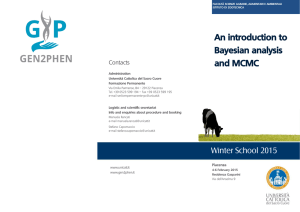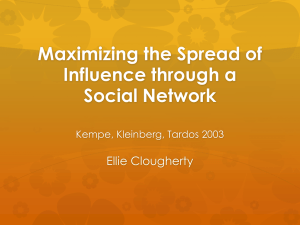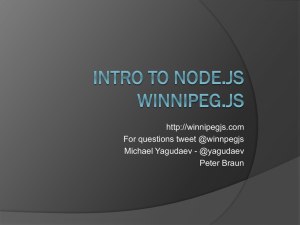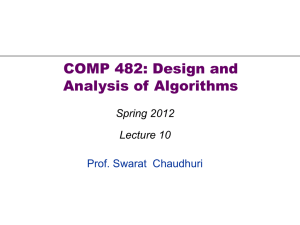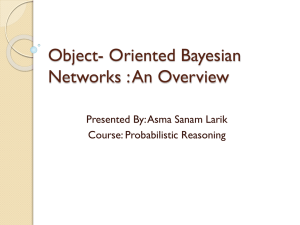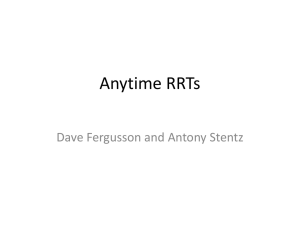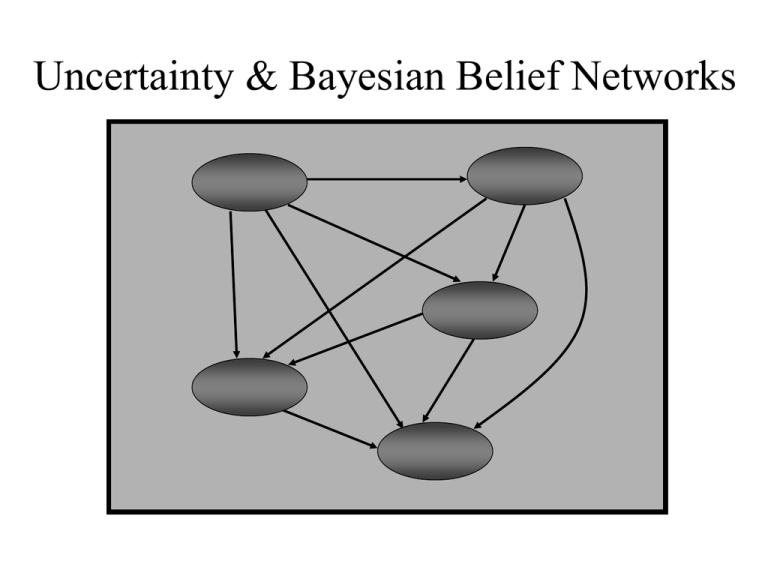
Uncertainty & Bayesian Belief Networks
Data-Mining with Bayesian Networks on
the Internet
• Internet can be seen as a massive repository
of Data
• Data is often updated
• Once meaningful data has been collected
from the Internet, some model is needed
which is able to:
– be learnt from the vast amount of available data
– enable the user to reason about the data.
– Be easily updated given new data
2
Section 1 - Bayesian Networks
An Introduction
•
•
•
•
•
•
Brief Summary of Expert Systems
Causal Reasoning
Probability Theory
Bayesian Networks - Definition, inference
Current issues in Bayesian Networks
Other Approaches to Uncertainty
3
Expert Systems
1 Rule Based Systems
• 1960s - Rule Based Systems
• Model human Expertise using IF .. THEN rules or
Production Rules.
• Combines the rules (or Knowledge Base) with an
inference engine to reason about the world.
• Given certain observations, produces conclusions.
• Relatively successful but limited.
4
2 Uncertainty
•
•
•
•
Rule based systems failed to handle uncertainty
Only dealt with true or false facts
Partly overcome using Certainty factors
However, other problems: no differentiation
between causal rules and diagnostic rules.
5
3 Normative Expert Systems
• Model Domain rather than Expert
• Classical probability used rather than ad-hoc
calculus
• Expert support rather than Expert Model
• 1980s - More Powerful Computers make complex
probability calculations feasible
• Bayesian Networks introduced (Pearl 1986) e.g.
MUNIN.
6
Causality - 1 Icy Roads
Icy Roads
Holmes Crashes
Watson Crashes
7
- 2 Wet Grass
Rain
Watson’s
Grass Wet
Sprinkler
Holmes’
Grass Wet
8
- 3 Earthquake or Burglar
Burglary
Earthquake
Alarm
Mary Calls
John Calls
9
Tour through Probability
• All probabilities are between 0 and 1
• Necessarily true propositions have probability=1
and necessarily false propositions have
probability=0
10
Conjunctions and Disjunctions
Venn Diagrams
• P(A & B) = P(A) x P(B)
A
B
• P(A v B) = P(A) + P(B)
(mutually exclusive)
A
B
• P(A v B)
=P(A)+P(B) - P(A & B)
(not mutually exclusive)
A
B
11
Conditional probability & independence
• Probability of B “given” A:
E.g. P(Hearts|Heart last time)
P(B|A)=P(A&B)
P(A)
• Independence:
E.g. P(Heads|Even) = P(Heads)
P(B|A)=P(B)
12
Probability Distributions
• Probability Distribution:
–
–
–
–
0.5
p(Weather=Sunny) = 0.5
p(Weather=Rain)= 0.2
p(Weather=Cloud)= 0.2
p(Weather=Snow)= 0.1
0.2
0.1
• NB Distribution sums to 1.
S R C S
13
Joint Probability
• Completely specifies all beliefs in a problem
domain.
• Joint prob Distribution is an n-dimensional table
with a probability in each cell of that state
occurring.
• Written as P(X1, X2, X3 …, Xn)
• When instantiated as P(x1,x2 …, xn)
14
Joint Distribution Example
• Domain with 2
variables each of
which can take on 2
states.
P(Toothache, Cavity)
Toothache
¬Toothache
Cavity
0.04
0.06
¬Cavity
0.01
0.89
15
Bayes’ Theorem
Simple:
P(Y|X) = P(X|Y)P(Y)
P(X)
General:
P(Y|X,E) = P(X|Y,E)P(Y|E)
P(X|E)
16
Bayesian Probability
• No need for
repeated Trials
• Appear to follow
rules of Classical
Probability
• How well do we
assign
probabilities?
The Probability Wheel:
A Tool for Assessing Probabilities
17
Bayesian Network - Definition
•
•
•
•
Causal Structure
Interconnected Nodes
Directed Acyclic Links
Joint Distribution formed
from conditional
distributions at each node.
18
Earthquake or Burglar
Burglary
Earthquake
Alarm
Mary Calls
John Calls
19
Bayesian Network for Alarm Domain
P(B)
.001
Burglary
B
T
T
F
F
A P(M)
T .70
F .01
E
T
F
T
F
P(A)
.95
.94
.29
.001
Mary Calls
Earthquake
P(E)
.002
Alarm
John Calls
A P(J)
T .90
F .05
20
Retrieving Probabilities from the
Conditional Distributions
• P(x1,…xn) = P P(xi|Parents(xi))
i=1
• E.g.
P(J & M & A & ¬B & ¬E)
= P(J|A)P(M|A)P(A|¬B,¬E)P(¬B)P(¬E)
= 0.9 x 0.7 x 0.001 x 0.999 x 0.998
= 0.00062
n
21
Constructing A Network
- Node Ordering and Compactness
•
•
•
•
•
Mary Calls
John Calls
Alarm
Burglary
Earthquake
Mary Calls
John Calls
Alarm
Burglary
Earthquake
22
Node Ordering and Compactness contd.
•
•
•
•
•
Mary Calls
Johns Calls
Earthquake
Burglary
Alarm
23
Node Ordering and Compactness contd.
•
•
•
•
•
Mary Calls
Johns Calls
Earthquake
Burglary
Alarm
Mary Calls
John Calls
Earthquake
Burglary
Alarm
24
Conditional Independence
revisited - D-Separation
• To do inference in a Belief Network we have to
know if two sets of variables are conditionally
independent given a set of evidence.
• Method to do this is called Direction-Dependent
Separation or D-Separation.
25
D-Separation contd.
• If every undirected path from a node in X to a
node in Y is d-separated by E, then X and Y are
conditionally independent given E.
• X is a set of variables with unknown values
• Y is a set of variables with unknown values
• E is a set of variables with known values.
26
D-Separation contd.
• A set of nodes, E, d-separates two sets of nodes, X
and Y, if every undirected path from a node in X to a
node in Y is Blocked given E.
• A path is blocked given a set of nodes, E if:
1) Z is in E and Z has one arrow leading in and one leading
out.
2) Z is in E and has both arrows leading out.
3) Neither Z nor any descendant of Z is in E and both path
arrows lead in to Z.
27
Blocking
X
E
Y
Z
Z
Z
28
D-Separation - Example
• Moves and Battery are
independent given it is
known about Ignition
• Moves and Radio are
independent if it is known
that Battery works
• Petrol and Radio are
independent given no
evidence. But are
dependent given evidence
of Starts
Battery
Radio
Ignition
Petrol
Starts
Moves
29
Inference
• Diagnostic Inferences (effects to causes)
• Causal Inferences (causes to effects)
• Intercausal Inferences - or ‘Explaining
Away’ (between causes of common effect)
• Mixed Inferences (combination of two or
more of the above)
30
Inference contd.
Q
E
Q
E
E
Q
E
Q
Diagnostic
Causal
E
Intercausal
Mixed
31
Inference contd.
Burglary
Earthquake
Alarm
Mary Calls
John Calls
32
Inference in Singly Connected Networks
• E.g. P(X|E):
Involves computing two values:
– Causal Support (evidence variables above X
connected through it’s parents)
– Evidential Support (evidence variables below X
connected through it’s children
• Algorithm can perform in Linear Time.
33
Inference Algorithm
E
Spreads out from Q to
evidence nodes, root
nodes and leaf nodes.
Causal Support
Each recursive call
excludes the node from
which it was called.
Q
E
E
Evidential Support
34
Inference in Multiply Connected
Networks
• Exact Inference is known to be NP-Hard
• Approaches include:
– Clustering
– Conditioning
– Stochastic Simulation
• Stochastic Simulation is most often used,
particularly on large networks.
35
Clustering
Cloudy
Sprinkler
Cloudy
Rain
C
C
T
F
P(S)
T
F
.08 .02
.40 .10
Wet Grass
Sprinkler & Rain
P(R)
.08 .02
.40 .10
P(S&R)
C
TT TF FT FF
T
F
.08 .02 .72 .18
.40 .10 .40 .10
Wet Grass
36
Conditioning
+
+
-
-
Cloudy
Cloudy
Cloudy
Cloudy
Sprinkler
Rain
Sprinkler
Rain
Wet Grass
Wet Grass
37
Stochastic Simulation - Example
A
A
0
1
P(B=1)
0.2
0.8
B
P(A=1) = 0.2
C
D
A
0
1
p(C=1)
0.05
0.2
E
38
Stochastic Simulation
•
•
•
•
•
•
•
Run repeated simulations to estimate the probability
distribution
Let Wx = the states of all other variables except x.
Let the Markov Blanket of a node be all of its parents,
children and parents of children.
Distribution of each node, x, conditioned upon Wx can be
computed locally from their own probability with their
children’s :
P(a|Wa) = . P(a) . P(b|a) . P(c|a)
P(b|Wb) = . P(b|a) . P(d|b,c)
P(c|Wc) = . P(c|a) . P(d|b,c) . P(e|c)
Therefore, only the Markov blanket of a node is required
to compute the distribution
39
The Algorithm
• Set all observed nodes to their values
• Set all other nodes to random values
• STEP 1
• Select a node randomly from the network
• According to the states of the node’s markov blanket,
compute P(x=state, Wx) for all states
• STEP 2
• Use a random number generator that is biased according to
the distribution computed in step 1 to select the next value
of the node
• Repeat
40
Algorithm contd.
• The final probability distribution of each unobserved node
is calculated from either:
1) the number of times each node took a particular state
2) the average conditional probability of each node taking a
particular state given the other variables states.
41
Case Study - Pathfinder
• Diagnostic Expert System for Lymph-Node Diseases
4 Versions of Pathfinder :
1) Rule Based
2) Experimented with Certainty Factors/Dempster-Shafer
theory/Bayesian Models
3) Refined Probabilities
4) Refined dependencies
42
Section 2 - Research Issues in
Uncertainty
1 Learning Belief Networks from Data
• Assume no
Knowledge of
Probabilities
Distributions or
Causal Structure.
• Is it possible to
infer both of these
from data?
Case Fraud
1
2
3
4
5
6
7
8
9
10
No
No
Yes
No
No
No
No
No
No
No
Gas
Jewellery
Age
Sex
No
No
Yes
No
Yes
No
No
No
Yes
No
No
No
Yes
No
No
No
No
Yes
No
No
30-50
30-50
>50
30-50
<30
<30
>50
30-50
<30
<30
F
M
M
M
F
F
M
F
M
F
43
Some Methods
• Bayesian (Cooper & Herskovitz 1991)
• Minimum Description Length (Lam &
Bachus 1994)
• Bound and Collapse (Ramoni 1996)
Fraud
Gas
Age
Sex
Jewelry
44
2 Dynamics - Markov Models
State Transition Model
State t-2
State t-1
State t
State t+1
State t+2
Percept t-2
Percept t-1
Percept t
Percept t+1
Percept t+2
Sensor Model
45
Updating over time
State t-1
State t
Percept t-1
Percept t
State t
Percept t
State t
State t+1
Percept t
Percept t+1
46
Dynamic Belief Networks Forecasting
Car
sales
t-1
t
Price
Demand
Supply
Price
Health
Demand
Health
Supply
47
3 Other approaches to modeling
Uncertainty
• Default Reasoning
• Dempster - Shafer
Theory
• Fuzzy Logic
48



